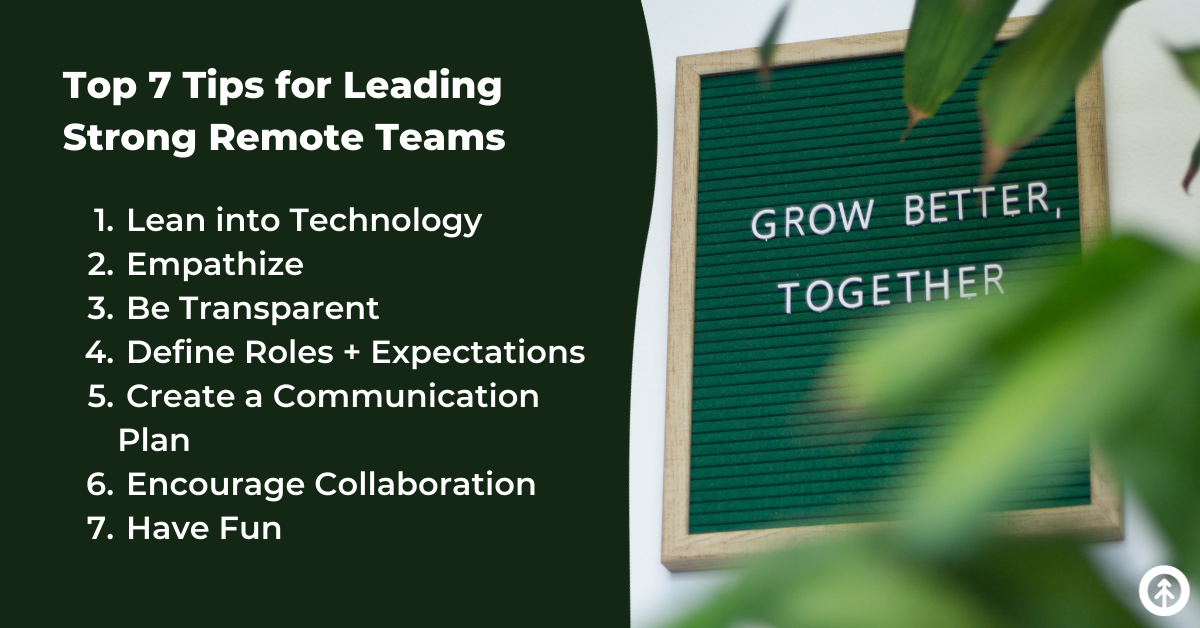7 Tips for Leading a Successful Remote Team
On this page
74% of U.S. companies are using (or plan to use) a hybrid work model permanently, with 55% of employees saying they want to work from home at least three days a week.
That’s a huge shift from just a few years ago, and it’s requiring leadership to redefine quickly how they lead their teams.
Growth has always been a remote workplace, so we thought we’d share our remote team leadership best practices to help make that pivot a little easier for those taking that leap.
Of course, each of these tips is important for leadership in general, but when you lead a remote or hybrid team, you must step them up to the next level to make it work.

Top 7 tips for leading a remote team, here we go:
- Lean into Technology
- Empathize
- Be Transparent
- Define Roles + Expectations
- Create a Communication Plan
- Encourage Collaboration
- Have Fun
1. Lean into Technology

If you’re wondering how your team can maintain communication, manage projects effectively, and share work quickly when team members are working remotely or in different time zones, we’ve got you.
Our Growth tech stack is tried and true for keeping teams working together smoothly from anywhere or at any time.
- HubSpot - More than a CRM, HubSpot tools ensure that data and information are shared across all your teams and that work is easily tracked and clear to everyone.
- Google Workspace - If you’re still using MS Suite to create documents, try the more collaborative, trackable G-Suite and keep all your documents (and all versions ever created) on the Cloud for easy access by everyone on your team.
- Asana - Asana is a project manager’s dream tool (as well as her team’s) because it has features that keep everyone organized, informed, and updated on every project, no matter how big or small.
- Slack - Slack allows teams, departments, and entire organizations to collaborate on its easy-to-use, chat-style interface and gets people out of their email inboxes and into #channels for communication. It's like an entire social media platform just for your team.
- Canva - Designers, writers, production teams, and project managers can work together to create stunning digital assets from infographics to videos in real-time.
2. Empathize
Check-in with your team on a regular, person-to-person basis—and not just around their work.
Knowing what’s going on in a team member’s life (with appropriate boundaries) goes a long way toward building a solid professional relationship with each member of your team and understanding them as human beings who just happen to do a great job for you with their talents, skills, and expertise.
When you listen actively and work to understand who people are as individuals, it’s easier to help when help is needed, offer encouragement and celebration appropriately, and communicate effectively.
3. Be Transparent

Effective leaders promote transparency to build trust no matter if their team is remote, hybrid, or in-office. But being transparent with your team works to do so much more.
Transparency Creates a Sense of Safety and Well-being.
People struggle when they don’t know what’s going on (especially so when they're remote), and every human will create a reason (one that’s way worse than the truth) if a reason isn’t given, so it’s best to be upfront with what’s happening with the business, the workplace, and with your thoughts around performance.
It helps people feel safe when they know they can trust their leaders to be honest and straightforward, even when it’s hard. And when people feel safe, they ask more questions, provide more input, and stay healthy, engaged, and productive.
Everyone wins in an environment like that.
Transparency Inspires Ownership.
When everyone is aware of the company's goals, they can work together to achieve them. So leaders should be open about the decisions being made in the business and be prepared to explain exactly why those decisions are being made.
This allows team members to provide input which gives them a sense of ownership in the company's success.
Plus, it’s just an awesome way to walk around in the world.
4. Define Roles + Expectations
Allow people to work together effectively by making sure everyone knows exactly what they’re supposed to do and how they’re supposed to do it.
Remember to set clear deadlines for tasks and communicate regularly with your team so everyone stays on track (Asana helps us a great deal with this).
In a scenario like that, no one feels that they’ve done too much or too little, yet the work still gets done, and that makes for a more stress-free workplace.
To start, consider not only what each member of the team brings to the table in terms of their current expertise, skills, and experience, but think about what they’re interested in learning as well. This gives people an opportunity to grow the ways in which they can help each other, the organization, and themselves.
By doing so, you will build a cohesive, collaborative team that can achieve great things remotely.
5. Create A Communication Plan
When it comes to remote work, communication is everything.
Without it, things can quickly start to unravel. That's why it's so important for managers of remote teams to have a clear and concise communication plan in place.
Here are a few tips:
- Write it down - Put everything in writing so there’s no room for misunderstanding and so that each team member can refer back to what you’ve written (which is all made easy when everyone communicates often in Slack, Asana, or HubSpot). This will help avoid any confusion down the road.
- Be Available - One of the challenges of managing a remote team in different time zones is that you're not always available when something comes up. However, it's important to be as accessible as possible so your team feels comfortable coming to you with questions or concerns. Make sure they know how best to reach you and always respond as quickly as possible.
6. Encourage Collaboration
When every member of your team feels like they’re a part of the team, they reach out to each other for help, advice, and encouragement. When they’re encouraged to do that around projects, they foster a collaborative spirit that allows them all to succeed together.
To create that, it’s up to you to build a culture of mutual respect, trust, and honesty.
How do you do that? #1 answer: model it.
Trust and respect your people openly by:
- avoiding micromanagement
- celebrating when they succeed
- listening to their suggestions and ideas
- giving them the credit they deserve
When you create a culture of respect, you create a safe environment in which everyone is comfortable asking for help and offering it when they see a team member in Slack who could use a hand.
.gif?width=1200&name=Lead%20Successful%20Remote%20Teams%20Growth%20Team%20Pic%20(2).gif)
Here are a few other tips:
- Encourage collaboration by being collaborative - pull in your expert team members (for Growth, that’s all of us) to help you solve issues that are on your plate.
- Create boundaries and expectations for how team members should work together to solve issues or complete projects.
- Use collaborative tools like Asana, Canva, HubSpot, and Google Drive to facilitate communication and collaboration between team members.
- Reward teamwork and collaboration when you see it, but consider creating incentives, programs, and events that promote teamwork.
7. Have Fun
One of the ways we build collaboration, cohesion, and growth as a team of experts is by having fun together.
It can be as simple as sharing a gif in Slack or as planned as our annual retreat in Big Sur, California.
But the key is to intentionally go out of your way to inspire it. Laugh along, be approachable, and be authentic.
When you’re hiring new team members, think of the team you already have and ask yourself these questions:
- Do they share traits in common such as kindness, generosity, humility, or playfulness?
- Do they have things to teach each other?
The Growth team is incredibly diverse, and we work well together from remote locations all over the world because of how different and unique we are.
A day at the "office" is a day with those we care about, admire, trust, and respect.
How did we get that way?
Our leader taught us how. That's how.
We’ve been a remote workplace since before it was fancy, so if leading a remote team is new to you and you have questions, reach out. As always, we’re right here (and remote at the same time).
Curious to know more about how we do what we do at Growth? Just ask.
Explore More Insights: Related Blog Posts
-
 SlackApr 14, 2021
SlackApr 14, 2021 Katrina Horne
Katrina HorneCommunicating + Collaborating Better with Slack
(last updated May 20, 2022) Slack professes its platform to be the future of business communication, and we...
-
 Inbound MarketingMar 31, 2020
Inbound MarketingMar 31, 2020 Ashley Lilly
Ashley Lilly5 Apps To Help Increase Productivity
If you’re wondering how your team can maintain communication, manage projects effectively, and share work...
-
 Team BuildingApr 23, 2021
Team BuildingApr 23, 2021 Katrina Horne
Katrina HorneUsing Project Management Tools to Work Better Together
(last updated April 6, 2022) Post-it notes, whiteboards, and spreadsheets can only take your business so far,...
-
 SlackNov 18, 2021
SlackNov 18, 2021 Growth Marketing Firm
Growth Marketing FirmAsana + Slack Hacks for Improving Team Workflows
Updated March 25, 2022 If your workflow solution involves Asana + Slack, and you’ve ever wished you didn’t...
-
 HubSpotSep 23, 2021
HubSpotSep 23, 2021 Growth Marketing Firm
Growth Marketing FirmBest Practice Tech Stack for Nonprofits
Growth Marketing Firm · Best Practice Tech Stack For Nonprofits (last updated 8/9/2022) As amazing as...
-
 HubSpotJun 2, 2023
HubSpotJun 2, 2023 Growth Marketing Firm
Growth Marketing FirmAutomating Gratitude: A Webinar for Non-Profits Using HubSpot
The holy grail of long-term nonprofit success involves delighting the donors you already have while...
-
 Inbound MarketingAug 25, 2023
Inbound MarketingAug 25, 2023 Growth Marketing Firm
Growth Marketing FirmInbound 2023: What to Expect & Why You Shouldn't Miss It
The buzz around INBOUND 2023 is palpable—and for a good reason.
-
 Inbound MarketingSep 6, 2022
Inbound MarketingSep 6, 2022 Growth Marketing Firm
Growth Marketing FirmHow to Connect LinkedIn + HubSpot Marketing Hub
Growth Marketing Firm · How To Connect LinkedIn + HubSpot Marketing Hub Growth Hack: connect your brand...
-
 HubSpotJan 20, 2023
HubSpotJan 20, 2023 Growth Marketing Firm
Growth Marketing FirmHubSpot Workflows to Increase Donor Retention + Engagement
Delighting the donors you have and consistently engaging new ones is the holy grail of long-term non-profit...



